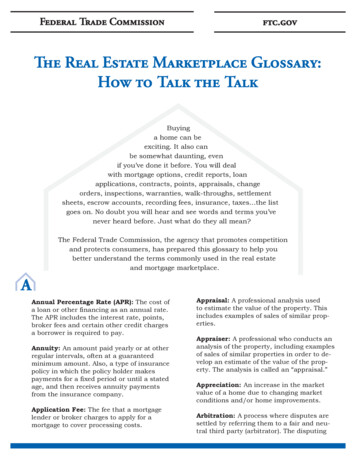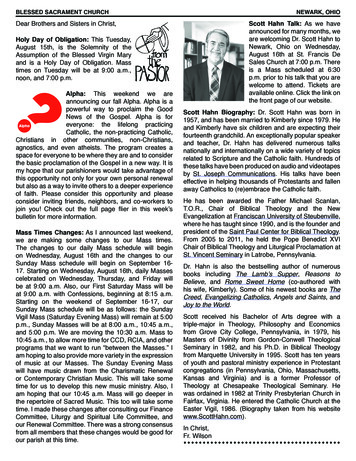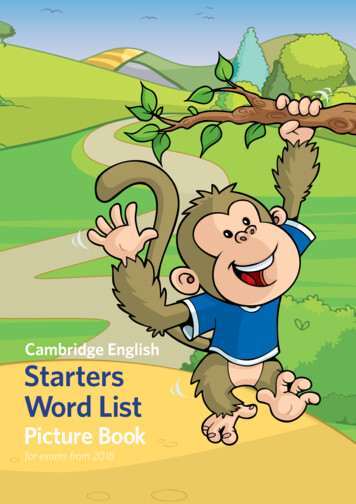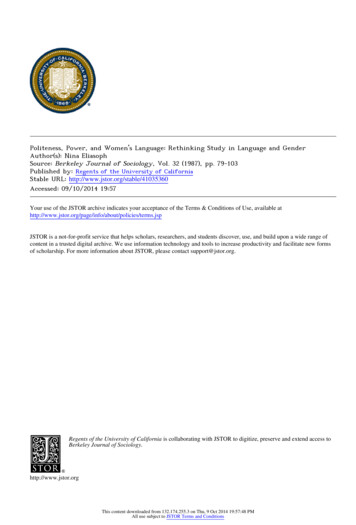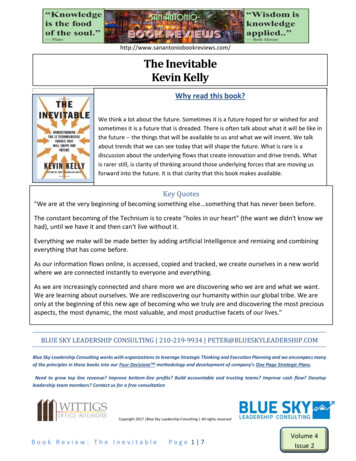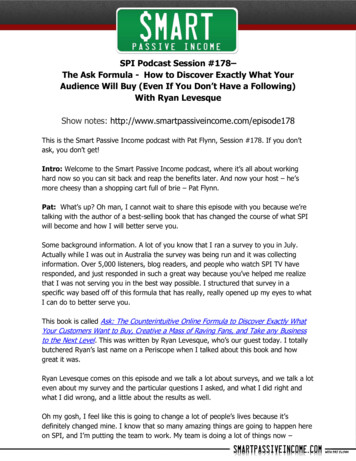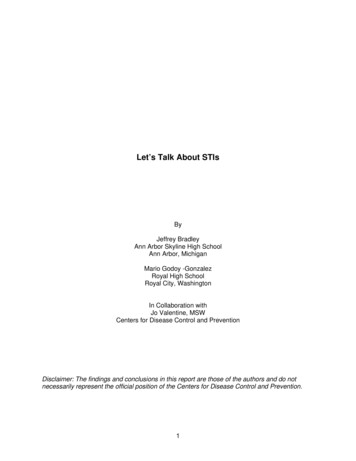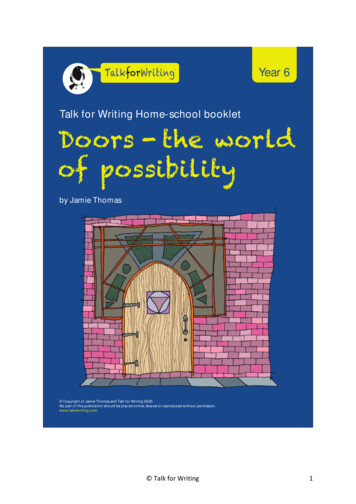
Transcription
Year 6Talk for Writing Home-school bookletDoors - the worldof possibilityby Jamie Thomas Copyright of Jamie Thomas and Talk for Writing 2020.No part o f this publication should be plac ed online, shar ed or reproduced without permission.www.talk4writing.c om Talk for Writing1
Doors- the world of possibilityYear 6 Workbookby Jamie ThomasIntroductionHave you ever looked at a door and wondered what might be on the otherside? Where may it lead? What may be hiding within? At first glance, a dooris just a piece of wood, glass or metal that is opened and closed so that peoplecan get in and out of a room, a vehicle or a space. But in the hands of a writer,a door represents a world of possibility, a world where things are not onlyhidden but often closed off and restricted. Together, through poetry, textgames and narrative, we shall explore the potential that a door offers to you,the writer. Talk for Writing2
Activity 1: The world we live inAs I write this, the world is in lockdown, shut behind doors for our own safetyand the safety of everyone else. Covid-19 has closed schools, closed shops andtemporarily closed some of the things we take for granted, like playing in thepark with our friends. Make a list of all the things that you miss doing. You may like to thinkabout some of the following categories:- seeing family- seeing friends- day to day things- playing sports- exploring your interests- places you love to visitThroughout these sessions, you may like to use these personal reflections toinspire and influence your writing.Activity 2: I opened the magical door and saw This is an idea inspired by Kit Wright’s poem ‘The Magic Box’ (you could searchfor this on the internet to read his poem). In the poem, Kit imagines what maybe contained inside a magical box. We can use this idea to connect to whatcould be behind the magical door. Before you begin, brainstorm a list of ideas for what might be behind thedoor. Let your imagination run wild as there is no wrong answer. Onceyou have your list, have a go at writing a poem, using the repeatingopener: I opened the magical door and saw Here’s an example to help you get going:I opened the magical door and saw shadows dancing.I opened the magical door and saw a rainbow leading toanother world.I opened the magical door and saw people crying.I opened the magical door and saw a magical fairgroundflooded in lights. Talk for Writing3
Once you have got your ideas, go back and see if you can add to them. Youcould add more description or bring the thing to life through action, e.g.I opened the magical door and saw a shoal of hungry shadows,tangoing through busy streets. Have fun adding to your ideas and let your imagination run wild. Have aread of this poem I created with some Y6 children to help you get ideas:The Magical DoorI opened the magical door and saw a world turned upside down:the sea, now a floating ceiling,the clouds, an inviting carpet.I opened the magical door and saw the reflection of myself:standing, searching, staring,questioning how this was possible.I opened the magical door and saw a sweet-treat paradise:clouds of candy floss,drifting across a bubble gum sky.I opened the magical door and saw a field of waves:blue potatoes were leaping,playing in white foam,as puzzled farmers watched from sunny shoresI opened the magical door and saw The image of a street I used to know,But as I entered, everything changed;As I reached out, everything had gone. Talk for Writing4
continued I opened the magical door and saw A forest of mirrors,surrounding me in dazzling white light,leading me into a world of mystery.I opened the magical door and saw A feast of my favourite foodsGuarded by monster chipsWaiting to fight off all invaders.I opened the magical door and saw Monstrous mobile phonesHerding people into little housesAnd laughing, laughing, laughing.I opened the magical door and saw The future. Reread what you have written and change some of the words so that itsays exactly what you want it to say. You may want to look at the writingchallenge below and add in some of these ideas.Writing Challenge: Can you explore more of the senses? You may like to try thefollowing pattern:IIIIIopenedopenedopenedopenedopenedthe magical door and saw the magical door and heard the magical door and smelt the magical door and touched the magical door and found Talk for Writing5
Activity 3: Artistic challengeDoors are not only exciting for what may lie behind them, they can bedesigned to invite you into their world. A few years ago, a derelict area ofFunchal in Madeira was transformed by local artists who decided to bring thedead doors to life. The beauty of the art opened new doors, and soon homes,shops and restaurants flourished there. Here are a few of those doors. Have a go at drawing, painting or creating your own door. What designwould you choose? What would it represent? Talk for Writing6
Activity 4: IdiomsAn idiom is a common word or phrase which means something different fromits literal meaning but can be understood because of its popular use, e.g.IdiomMeaningBeat around thebushAvoid saying what you mean, usually because it isuncomfortableBite the bulletTo get something over with because it is inevitable Below is a list of idioms about doors. Can you work out what they mean?IdiomMeaningas one door closes, anotheropensat death’s doorbehind closed doorsthrough the back doordead as a doornailfoot in the doorkeep the wolf from the doorknocking on heaven’s doorleave the door openshow somebody the doorslam the door in somebody’sface Talk for Writing7
Activity 5: ‘The Door’In this session, we are going to consider theimportance of fluency and expression whenwe read. Begin by reading Miroslav Holub’spoem The Door. You may like to listen tothese two contrasting performances:https://www.youtube.com/watch?v 3r Decide which reading you prefer andwhy and jot down your response.The Doorby Miroslav HolubGo and open the door.Maybe outside there’sa tree, or a wood,a garden,or a magic city.Go and open the door.Maybe a dog’s rummaging.Maybe you’ll see a face,or an eye,or the pictureof a picture.Go and open the door.If there’s a fogit will clear.Go and open the door.Even if there’s onlythe darkness ticking,even if there’s onlythe hollow wind,even ifNow make some notes on the poem:nothinga. What did you like about the poem? What is there,go and open the door.was your favourite line and why?b. How did the poem make you feel?c. Which line in the poem did you find the At leastthere’ll bemost interesting and why?a draught.d. Are there any parts of the poem thatleave you with unanswered questions?Miroslav Holub, ‘The door’ trans. Ian Milner, Poemse. What questions would you like to ask the Before & After: Collected English Translations(Bloodaxe Books, 2006)poet, Miroslav Holub?www.bloodaxebooks.com Decide how you would perform this outloud and have a go at performing at home. Talk for Writing8
Activity 6: ComprehensionRead this extract from The Snow-Walker's Son by Catherine Fisher. You can listento the extract here: 0hpt715The door was the last one in the corridor.As the flames flickered over it, they showed it was barred; a hefty ironchain hung across it, and the mud floor beneath was red with rust that hadflaked off in the long years of locking and unlocking.The keeper hung his lantern on a nail, took the key from a dirty string aroundhis neck, and fitted it into the keyhole. Then he looked behind him.'Get on with it!' the big man growled. 'Let me see what she keeps in there!'The keeper grinned; he knew fear when he heard it. With both hands he turnedthe key, then tugged out the red chain in a shower of rust and pushed the door.It opened, just a fraction. Darkness and a damp smell oozed through the blackslit.He stepped well back, handed the stranger the lantern, and jerked his head. Hehad no tongue to speak with; she'd made sure he kept her secrets.The stranger hesitated; a draught moved his hair and he gazed back up the stonepassageway as if he longed suddenly for warmth and light. And from what I'veheard, the keeper thought, you won't be seeing much of those ever again.Then the man held up the lantern and pushed the door. The keeper watched hisface intently in the red glow, and his great hand, as it clutched a luck-stone thatswung at his neck. The man went in, slowly. The door closed. Catherine Fisher 2011 from The Snow Walker's Son, published by Red Fox, by permission of the author.1. The door was the last one in the corridor.What is the significance of the word last? Can you think of another contextwhere the word last has a significant meaning? e.g. the last chance.2. How do the opening lines (highlighted above) set the mood of the story?What are your immediate impressions?3. Having spent a great deal of time reflecting on the significance of doorsand their appearance, what does this description suggest to you?4. Why has Fisher described the iron chain as being ‘hefty’? What could thesignificance of this word be in the context of the story?5. Darkness and a damp smell oozed through the black slit.How does this make you feel as a reader? What is the relevance of bothdarkness and a damp smell? Do either of these surprise you; if so, why? Talk for Writing9
Activity 7: Grammar & Sentence Worka. Pattern of three:Fisher uses the pattern of three actions in a sentence to advance the actionand inject a sense of pace into her writing. This helps to balancedescription, action and dialogue. e.g. The keeper hung his lantern on a nail, took the key from a dirtystring around his neck, and fitted it into the keyhole. With both hands he turned the key, then tugged out the redchain in a shower of rust and pushed the door. He stepped well back, handed the stranger the lantern, andjerked his head. Can you come up with three of your own sentences using this skill?b. Semicolon for independent clausesA semicolon can be used between independent clauses that are closelyrelated in theme. In the following sentences, Catherine Fisher chooses touse semicolons in both of these sentences rather than using a joining word(conjunction) like because. The keeper grinned; he knew fear when he heard it. He had no tongue to speak with; she'd made sure he kept hersecrets. In your opinion, why has she made this choice and what impact does ithave on you as the reader? Can you write two or three sentences of your own that illustrate thepower of the semicolon over the use of a conjunction? Talk for Writing10
c. Adverbs – roving reportersIn the sentences below, the adverb ‘slowly’ is used to describe how the manenters the room. Adverbs are like roving reporters – they can be movedaround the sentence, e.g.a. The man went in, slowlyb. Slowly, the man went in.c. The man went slowly in.d. The man slowly went in.By changing the position of the adverb, we can often either alter themeaning or add emphasis to a sentence. In this instance, by placing theslowly at the end, we infer that the character has a heightened awarenessof the situation they are in and therefore deliberately enters with caution. Try playing around with the adverb position in the following sentences.Consider how it alters the meaning and where the emphasis is bestplaced.1. Cautiously, Samantha crept towards the door that stoodbefore her.2. Sadly, the boy stared out of the window. Now try this out with a sentence of your own. Talk for Writing11
Activity 8: Through the eyes of a characterOne of the things I love exploring when I’m writing is what must be going on ina character’s mind. Whenever I read great portal stories, I always try to putmyself into the shoes of the character, to try to imagine how they must befeeling as they discover this passageway to a new world. How must Alice havebeen feeling as she fell through the never-ending tunnel into Wonderland?First, think of your character – it’s easier if you base this on someone youknow. What are they called? What do they look like? What sort of a person are they (miserable/friendly/kind/aggressive)? What do they say? What do they do? How do they treat other people? How do other people treat them?Now compose a short piece of descriptive writing based on seeing amysterious door through the eyes of your character. To do this, we will use asimple opener to drop the reader straight into the action:Samantha stared. Ali hesitated. We will also try to use some of the tools we explored in The Snow Walker’sSon. Look at this example: Talk for Writing12
Samantha stared. There, rising out of the cliff, was an unfamiliardoor; its metallic panels were tarnished in rust. Paint flaked off thebrittle walls that made up its frame and the door handle rattled inthe bitter breeze. Slowly, Samantha gazed all around her, took adeep breath and stepped forward.Here are the tools I used: Show the setting through theeyes of the main character(MC)Samantha stared. Describe the door/portal. (Youmay like to use two sentencesthat are closely linked inmeaning and connect themwith a semicolon.)There, rising out of the cliff,was an unfamiliar door; itsmetallic panels were tarnished inrust. Add some more detail.Paint flaked off the brittle wallsthat made up its frame and thedoor handle rattled in the bitterbreeze. Include an adverb to hint athow the MC feels. Remember,you can move the positionwithin the sentence.Slowly, Use the pattern of three toSamantha gazed all around her,advance the action and inject a took a deep breath and steppedsense of pace into your writing. forward. Now Imagine your main character is walkingalong the road when they come across a mysteriousdoorway. Describe this through their eyes. Use mymodel above to help you. Talk for Writing13
Session 9: Planning a portal storyNearly all portal stories follow a similar pattern: Main character (MC) finds magical portal & enters new world Describe new world MC explores this new world & encounters a problem MC has to escape & return through the portal MC cannot find portal again(sometimes brings back a memento of new world)Once you have identified the pattern of the story, the possibilities are endless.Let your imagination run free. Brainstorm lots of ideas and then decide whichcaptures your interest as a writer. Before you start, take a look at my top tips.Top tips for story writing: Start in a world/a setting that you know well – it is far easier to describesomething familiar to you, e.g. a garden, your school, your local town, etc. Use a stimulus (e.g. picture) for the new world – an image will help youfocus in on the detail and describe what is there. Let your ideas flow – don’t worry about spelling, handwriting orpresentation you can go back and edit this later.Here are a couple of ideas to open your mind to the world of possibility:Underlying PatternStory idea 1Story idea 2Main character (MC)finds magical portal andenters new worldElif is playing in herGrandmother’s gardenand notices a small fairydoor. Touches door andshrinks/ enters.Josh and Archie playinghide and seek in theirhouse. Archie openshatch in the roof anddiscovers new world. Talk for Writing14
Describe new worldArrives in anunderground world fullof caves, gianttoadstools and magicalcreatures.Transported to lifeonboard an enormoussailing ship in TudorEngland.MC explores new worldand encounters aproblemElif explores new worldand enters an areastrictly forbidden. Picksmagical flower.Ship is thrown intobattle.MC has to escape andreturn through theportalAlarms sound and Elifruns. She is chasedthrough the magicalworld by unknownthreat and escapes.Archie desperatelysearches for portal andway back to own world.MC cannot find portalagain (sometimes hasbrought back amemento of new world)Elif cannot find fairydoor again, but the cutflower lives on foreverreminding her of herjourney.Archie escapes withsmall pouch ofgunpowder in his pocket. Using this underlying pattern, plan a few portal stories of your own. Youmay like to draw upon your own personal experience as well as yourwider reading and imagination. I have also included two pictures in casethey help you. Talk for Writing15
Session 10: Writing your own storyYou now have all of the tools required to write your own portal story. You maylike to write about a more traditional portal that leads you to a magical world,or you may prefer to draw upon your personal experiences, as we haveexplored throughout this unit.To recap on all the key points we’ve been learning:a. Describe the portal in detail. You may want to show the portal throughthe eyes of the main character.b. Think about what lies on the other side of the door. Allow yourself theopportunity to write about what interests you and what is important toyou.c. Great writers steal ideas (‘magpie’) from other great writers. Reflectupon the portal stories that you have loved reading and consider whatmade these so engaging. Try to bring in some of these skills andtechniques into your own work.d. Enjoy it. Writing is all about sharing a passion for words, stories and theworld of possibility. If you love the story you are writing – so too willyour reader. Now write your portal story, drawing on all that you have learned. Don’tforget to share or publish your work – great writing deserves an audience! Talk for Writing16
This workbook has helped me learn Happy reading and writing! Talk for Writing17
Jamie Thomas for Talk for WritingJamie Thomas, former Deputy Head and Head of Warren Teaching SchoolAlliance, now works with Talk for Writing to help schools develop theapproach.To find out more about Talk for Writing, visit www.talk4writing.com.This resource is copyright. All materials herein, texts and supporting resourcesare copyright to Jamie Thomas & Talk for Writing. They are to be used tosupport children/staff/parents in home-learning ONLY and not for commercialgain or for training or sharing widely, in their original form or any variations.They must also not be shared online or on any social media platforms.Thanks to Jon Ralphs for the cartoons: jonralphs.comThanks again to Catherine Fisher for granting us permission to use the extractfrom The Snow-Walker's Son Talk for Writing18
The keeper hung his lantern on a nail, took the key from a dirty string around his neck, and fitted it into the keyhole. Then he looked behind him. 'Get on with it!' the big man growled. 'Let me se
